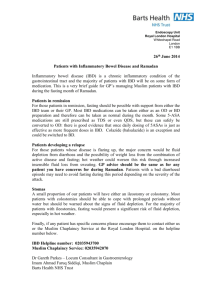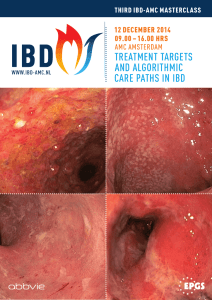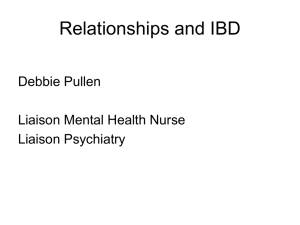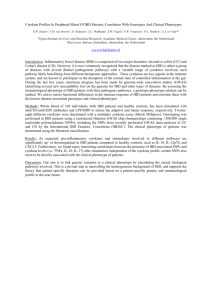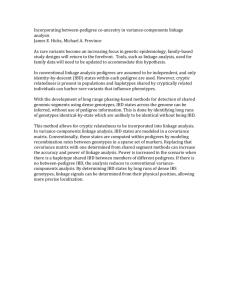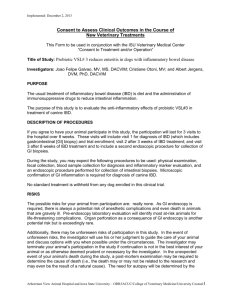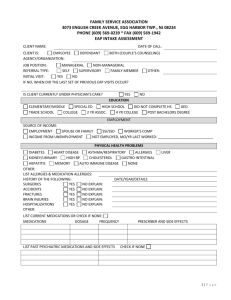case studies - Advances in Inflammatory Bowel Diseases
advertisement
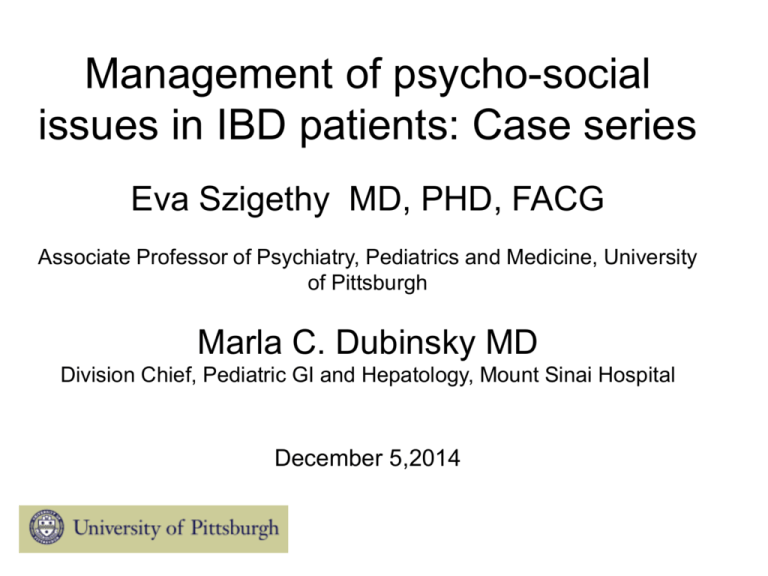
Management of psycho-social issues in IBD patients: Case series Eva Szigethy MD, PHD, FACG Associate Professor of Psychiatry, Pediatrics and Medicine, University of Pittsburgh Marla C. Dubinsky MD Division Chief, Pediatric GI and Hepatology, Mount Sinai Hospital December 5,2014 Disclosure: Szigethy • Sources of Funding – – – – – – – CCFA Senior Investigator Award NIMH R01 Grants American Psychiatric Press Inc., Book Editor Merck- Consultant, Advisory Board AbbVie- Consultant, Advisory Board GI Health Foundation- Honorarium iHope Network Inc. Scientific Advisor • All medication suggestions in this presentation are off-label uses unless noted otherwise. Disclosure: Dubinsky • Consultant for –Janssen, Abbvie, UCB, Pfizer, Takeda, Shire, Genentech, Prometheus Labs, Salix Objective • Use case examples to illustrate key diagnostic and treatment decisions in addressing psychosocial concerns in patients with IBD – Anxiety – Depression – Chronic Pain Case # 1: “I can’t stop worrying about getting sick again” • 13 year old female (Ann) with inactive ulcerative colitis presents with extreme anxiety about having a flare which significantly worsened over the past year. • ᵠsxs: worrying, restless, muscle tension, poor sleep, • • • • avoidance of public bathrooms, less social with friends due to worry about not being accepted. Diagnosed with IBD when she was 5 years old Current medications: Azathioprine No past medical or psychiatric history Social history- good social support, intact family, adequate functioning in school. Spectrum of Anxiety Psychopathology in IBD Ann • Mild • Age appropriate worry • Adjustment disorder • Sick role behavior (parental modeling Functioning OK Moderate • Generalized Anxiety Disorder • Panic Attacks • Illness Anxiety Disorder (somatization) Severe • Obsessive compulsive disorder • Panic attacks • Post traumatic stress disorder Poor functioning (avoidance) Generalized Anxiety Disorder (GAD) • Excessive worry (apprehensive expectation) about several events or activities for at least 6 months • At least 3 of following symptoms: – Restless – Fatigue – Concentration – Irritable – Muscle tension – Sleep disturbance Behavioral Interventions First • Listening to Ann process experience with IBD in empathic. • Cognitive behavioral therapy for 8-12 sessions over 3 months to teach Ann: – Relaxation techniques to target autonomic arousal – Cognitive restructuring to alter anxious reactions to anxiety provoking situations (socializing with friends) – Graduated controlled exposure tasks to prevent avoidance. • Family education • 70% response rate after 3-6 months of behavioral treatment Augmentation with antidepressant • Ann has 50% improvement in anxiety but now is starting to avoid school due to anxiety about upcoming colonoscopy. • Add Fluoxetine (SSRI) up to 40 mg by week 12 or Sertraline 100150mg by week 8 • If no response, switch to Venlafaxine (SNRI) up to 225 mg by week 12. • • • • • Possible Side Effects Activation common 1015% Bipolar switch uncommon (< 1%) GI side effects early Easy bruising and bloody noses Suicidal activation Ann’s case continued: • Ann’s mother reports that she woke up during a colonoscopy 4 years ago and was extremely nervous about it then but now over past 3 weeks has started to have nightmares about it and is saying she is going to refuse the upcoming colonoscopy. She has also become more tense and irritable. • Consider acute stress disorder or reactivation of perceived “traumatic” event- Traumatic or Stress DO – Re-experiencing – Avoidance – Hyperarousal • In DSM-5- PTSD no longer anxiety disorder. Unspecified Trauma and Stressor-related Disorder now also a consideration. Treatment plan for Ann • SSRIs can cause activation and nightmares so may consider lowering her dose. • School 504 plan to facilitate school attendance • Add trauma-focused elements to her cognitive behavioral therapy – Education about trauma and reactions – Additional relaxation techniques (hypnosis) – Help her identify feelings and tell her story while creating corrective narrative – In vivo mastery of trauma reminders • Consider post-poning colonoscopy if feasible Medications for Pediatric PTSD • There are no “magic pills” for PTSD. Medications are used to target specific persistent symptoms. • Mood stabilizers (Lamotrigine) for irritability • Beta blockers (propranolol) or alphaadrenergic agonists (guanfacine) for hyperarousal. Which team member to diagnose and treat? Psychiatrist-psychiatric medication and complex case consultation Severe Psychologist-behavioral management and coordination Moderate Social worker- life management and team coordination; transition of care; caregiver burnout GI Nurses- Medical education Mild Gastroenterology- Medical decisionmaking ©Szigethy and Regueiro 2014 Case #2 “ I just want to die. I feel like such a freak compared to the other kids” • 16 year old male (Joe) with Crohn’s disease who presents depressed and suicidal. • Diagnosed at age 13. Initial good response to infliximab but lost response and required surgical resection 1 year ago. • Ongoing active disease (inflammation) and just learned that his ostomy will not be reversed. • Denies pain or other medical symptoms. Joe’s depressive symptoms • Irritable mood • Anhedonia (no pleasure or motivation • Poor sleep • Fatigue • Low self-esteem • Suicidal (no plan or previous attempts) • No guns at home • Switched to home schooling and social isolation from friends • No previous psychiatric history • Denies alcohol or drug use including marijuana • Negative family psychiatric history Spectrum of Depressive Psychopathology in IBD Joe • Mild • Age appropriate mood lability • Adjustment disorder • Brief sickness behavior during acute IBD flare Moderate • Major Depression (>2 weeks) • Dysthymia (> 1 year) • Chronic sickness behavior +/IBD flare Severe Major depression with suicidality +/Comorbid psychiatric disorder +/Extreme life stress (ostomy) Suicide Assessment: Root Cause Chain Analysis for Suicide • Identify series of events that led to recent suicidal crisis • Aims to identify Joe’s precipitating thoughts, feelings, and actions Joe’s Case: Hate IBD embarrassed by ostomy love interest for prom wants to die rejected by Treatment Steps for Joe • Treat underlying inflammation- GI team • Facilitate education about ostomy and help Joe process his story but “I don’t want to talk about it” common. • Psychotherapy (12-20 sessions) to help him problemsolve using cognitive behavioral therapy. – Root cause chain analysis, Safety planning, education, reasons for living – Cognitive behavioral skills training, family work • • • • Activity Selection Goal-setting Problem-solving training Identify and alter negative cognitive distortions • 65% of depressed/suicidal patients respond to psychotherapy alone Stanley 2009; Maalouf & Brent, 2012; Szigethy 2012; 2014 Medication decisions for depression in pediatric IBD • If inactive IBD.......then SSRI first line if does not work switch to different class SNRI (duloxetine 20-40mg) • If active IBD………then bupropion first line (150300mg) • If comorbid pain….then SNRI first or low dose TCA added Case # 3: “The pain is constant and ruining my life. I hate how they treat me like an addict when I go to the ER for relief.” • 28 year old female (Sue) with inactive Crohn’s disease but over past year abdominal pain is constant, “10 out of 10 severity”. • Mild increase in pain with eating. No change with defecation. Had intermittent pain with disease activity in past. This new bout of constant pain started after C-diff infection. • CD diagnosed 4 years ago. No surgeries. • Medications: Fentanyl patch and oxymorphone pills prn x 6 months. Citalopram-started 1 year ago for pain, 6-MP • Other pain syndromes- fibromyalgia and chronic headaches. No other medical diagnoses. • Patient goes to multiple ERS to get narcotics and "fights" with staff/MDs when time comes to cut down meds. • Feels depressed and fatigue but no current psychiatric diagnoses. Pain also interferes with sleep. Sue’s formulation • Has many characteristics of “central” pain prone phenotype (CNS mediated pain) – Female, history of other chronic pain syndromes, catastrophizing – Also assess for early life trauma • IBD-IBS pain from peripheral nerve sensitization after C-diff exposure also possible. • Need to assess if narcotic use has evolved into substance abuse/dependence. Spectrum of Pain Psychopathology in IBD SUE • Mild • Brief pain related to gastroenteritis or IBD flare (CD > UC) • Sick role behavior (parental modeling Moderate Severe • IBD- IBS (irritable bowel syndrome)possible postinfectious Central chronic pain +/Multiple pain syndromes +/- • Somatic symptom disorder (somatization) Childhood trauma +/Psychopathology +/Narcotic use Treatment Plan for Sue • Build a strong therapeutic relationship to improve motivation and educate about neurobiology of pain circuits. • Teach behavioral interventions for pain management- distraction techniques and hypnosis so “brain” can be less reactive to “false alarm” pain signals. • Behavioral sleep interventions and sleep hygeine • Begin appropriate alternative non-opioid pain medications. • Explore willingness to come off opiates Concerns with Opiates in IBD • No evidence of efficacy for chronic abdominal pain • Psychological/physical dependence • Higher rates of infection/mortality • Narcotic Bowel Syndrome (NBS) versus Tolerance Grunkmeier 2007; Lichenstein 2006; Non-opioid pharmacotherapy for Sue • SSRIs (citalopram) can help anxiety and depression but rarely help pain directly. • Add a tricyclic antidepressant at night. • Start low and go slow. Usual dose range between 50-150 mg/day • Analgesia starts to occur after a week and can take 3 weeks to reach max efficacy. • Amitriptyline (3 ◦) more sedating • Nortriptyline (2◦) less sedating • Desipramine (2◦) least sedating Drossman 2009; Dekel 2013; Szigethy & Drossman 2014 Other Pharmacological options (off-label): Visceral Pain CLASS TYPE MECHANISMS for PAIN CONTROL Antidepressants TCAs Increased SE, endogenous opioid release, anti-inflammatory? SNRIs Stimulants Methylphenidate D-amphetamine Influence NE, SE, DA, endogenous opioids Mood stabilizers Gabapentin/pregabalin Central voltage-gated calcium channels? Atypicals Quetiapine? DA, SE, Adrenergic antagonism Glutaminergic Memantine ? Glutamate antagonism Antiinflammatory Doxcycline ? Central or peripheral inflammation Ford, 2008; Drossman 2002; Taylor 2007; Houghton 2011; Grover 2009; Szigethy and Drossman, 2014 Opioid Detoxification for Sue • Attempt outpatient taper but inpatient medical hospitalization if necessary • 10-33% daily reduction of i.v. morphine or hydromorphine equivalent • Clonidine for withdrawal symptoms • Benzodiazepines for extreme anxiety • Continue non-opioid pain medications • Appropriate management of bowel motility (constipation or diarrhea) • Continue behavioral interventions • 70% success rate but high recidivism at 3 months if aggressive non-opiate pain management not continued. Rational Approach to Chronic pain • Address false expectations or beliefs of patients • Provide neurobiological explanation of patient’s symptoms that psychopharmacological agent would target • Provide information/rationale aligned with patient’s interests/concerns • Negotiate treatment plan – Benefit in 4-6 weeks – Most side effects decrease in 1-2 weeks – Consider previous drugs that works and family history of drug response Personalized Psychosocial Management Pathways Active IBD IBD Meds Inactive IBD Coping therapy Cognitive behavioral therapy Hypnosis Psychotropic medication Psychotropic medication Exercise
